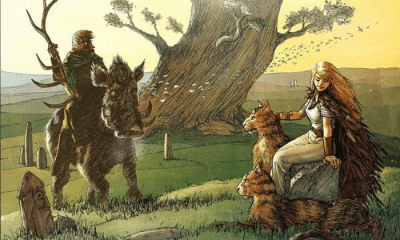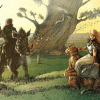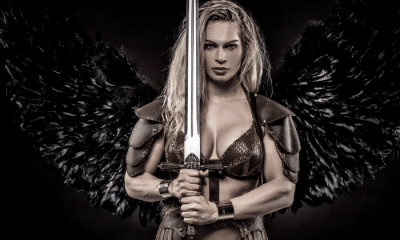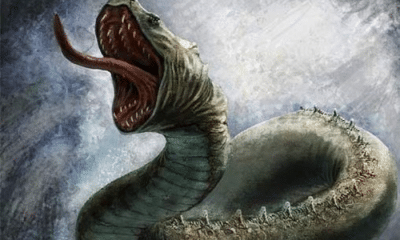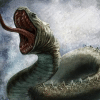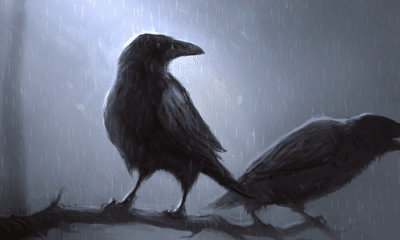Where Was Muspelheim?
Muspelheim was the land of fire that that was essential for the the creation and destruction of the world, but was it really even a feature of Norse mythology?
According to surviving legends, Muspelheim was the primordial world of fire in the cosmology of the Norse people.
In the beginning of creation, the heat of Muspelheim and the ice of Niflheim had combined to create Ymir, the giant whose body was used to form the world. Sparks from the realm of fire became the sun, moon, and stars in the sky.
Muspelheim was home to a race of fire giants, led by Surtr. Enemies of the gods and mankind, they would invade and burn the world at Ragnarök.
Most of what we know of this land from a single source, however.
Not written until the 13th century, the accuracy of its portrayal of Viking Age beliefs is questionable. Its depiction of Muspelheim and the end of the world may be influenced by many cultures of than the Norse.
Muspelheim, Surtr, and Ragnarök are famous elements of Norse mythology, but historians believe that the stories may not be entirely Norse at all.
Muspelheim: The Land of Fire
In Norse cosmology, Muspelheim was a world of fire.
There were nine worlds that were supported by the great World Tree, Yggdrasil, according to Scandinavian writers. Only one of these, Midgard, was home to humans and could be seen by them.
According to the most well-known sources, Muspelheim was one of the first two worlds to come into existence.
In the beginning, the nearly empty void of Ginnungagap occupied the space that would later be taken up by the Nine Worlds. The well Hvergelmir that fed Yggdrasil began to drip water into this featureless space.
The northern regions of Ginnungagap were so cold that the water froze into thick sheets of ice. The southern pole of the void was hotter, however, and the dripping water made sparks fly out in violent bursts.
The north became Niflheim, a land of ice and frost. The south was Muspelheim, the land of fire.
The water and heat that met in the center of Ginnungagap came together to form a thick mist. From this emerged the form of Ymir, the primordial giant whose body later formed Midgard.
Sparks continued to fly forth from Muspelheim even as Midgard was created.
These were captured in to become the sun, moon, and stars. They were placed in Ymir’s skull, which was made the dome of the sky over Midgard.
Muspelheim was one of the two primordial realms from which the rest of the Nine Worlds were created. These worlds rose along the branches of Yggdrasil with Niflheim and Muspelheim at either end.
Niflheim, the world of cold, was later made the home of Hel, the goddess of the dead. Her subjects, the decaying wraiths who had been sinners and criminals in life, resided in this frozen realm.
Muspelheim, meanwhile, was the home of a race of jötnar, creatures that are usually interpreted in English translation as giants or trolls. The fire giants of Muspelheim were led by Surtr.
More well-known than the Norse story of creation is the tale of how the world will be destroyed. Ragnarök, the end of the world, was foreshadowed in many of Norse mythology’s legends.
In these, Muspelheim and its inhabitants will play just as large of a role in the destruction of the world as they did in its creation.
The Prose Edda and other medieval sources say that Midgard and the worlds of the gods will be invaded by two armies at Ragnarök. Hel will lead the dead from Niflheim, along with her father Loki, when the serpent Nidhogg frees them from the World Tree’s root.
Surtr and the fire giants will invade from the south. They will bring with them the terrible fires of Muspelheim.
When Surtr and the giants of Muspelheim begin to cross the Bífrost, the rainbow bridge that connects Midgard and Asgard, Heimdall will sound the horn that announces the final battle between the gods and their enemies.
As the gods join in the last battle, Surtr will face off against Freyr. Freyr will die in the fight because he gave his best sword to his servant, Skírnir.
Surtr and the fire giants will burn the world as the gods die. Just as Midgard was created by the sparks of Muspelheim, its flames will destroy it.
The land of Midgard will be burned away, but the Prose Edda continues to say that this will only be the end of one era. New fertile land will emerge and the surviving gods and humans will create a new world, while Muspelheim’s inhabitants will once more be contained in their own world.
My Modern Interpretation
The stories of Muspelheim and the role its inhabitants will play in Ragnarök are regarded as central aspects of Norse mythology. It’s important to remember, however, that they have been passed down to us by later sources.
One of the most complete works regarding the legends of ancient Scandinavia is Snorri Sturluson’s Prose Edda. This was not written, however, until the 13th century.
The Viking Age had reached its peak nearly three hundred years before Sturluson’s time and Scandinavia was almost entirely Christianized by the time the Prose Edda was written. Snorri Sturluson was not documenting the beliefs of his age, but ancient stories from a culture that was rapidly changing.
In addition to not being as familiar with the myths as an earlier Scandinavian person would have been, Sturluson was also more heavily influenced by the writings of other cultures. Christianity had brought the Norse lands under the influence of a Near Eastern religion that had been filtered through Roman culture.
Many modern historians believe that Sturluson’s view of Ragnarök, and the role Muspelheim would play in it, was largely influenced by these cultures.
Surtr was depicted in the Prose Edda as having a flaming sword, bringing to mind the Biblical story of the angel that guarded the gates to the Garden of Eden. On the whole, these historians believe that Sturluson’s army of fire giants was heavily influenced by medieval Christian imagery of the demons and fallen angels of Hell.
The entire story of Ragnarök, in fact, bears some resemblance to the Christian concept of Armageddon.
Other historians have noted similarities between the fire giants of the Prose Edda and the German legend of the Red Jews. According to German belief from the same period as Sturluson’s writings, one of the lost tribes of Isreal would one day invade Europe and bring about the end of the world.
Even if the jötnar of Muspelheim were not originally based on these conceptions, the Prose Edda’s version of Ragnarök, by far the most complete account, was almost certainly influenced by medieval Christian belief.
The elements of Muspelheim that were not Christian in origin may still have not been as old as other aspects of Norse mythology.
A common interpretation of the jötnar of Muspelheim is that they are volcanic entities. Muspelheim and its involvement in both the creation and destruction of the world have similarities to Underworld legends from many other cultures.
Scandinavia, however, is not a volcanic region and the stories of Muspelheim and Surtr are too prominent to be relics of a culture old enough to have had first-hand experience with volcanic eruptions.
The one place in the Norse world that may have directly influenced the volcanic nature of Muspelheim would be Iceland. That island, however, was not settled by the Norse people until the year 1000.
If Muspelheim and the fire giants were modeled after Iceland’s volcanoes, they would have been later additions to the mythology. Some jötnar may have been originally conceived as fire beings, but the volcanic nature of Muspelheim and their invasion of the world could only have come from Iceland.
This may have begun early in the 11th century when Iceland was first settled by Danish people. Snorri Sturluson himself was Icelandic, however, making it just as likely that the eruption of fire beings to burn the world was another of his additions to the mythology of his ancestors.
In Summary
According to the Prose Edda, the most complete retelling of Norse mythology, Muspelheim was a primordial land of fire. Its heat had melted the ice of Niflheim to create Ymir, the giant whose body was used to make the world of men, and sparks from Muspelheim became the sun, moon, and stars.
The fire giants, or jötnar, of Muspelheim were ruled by Surtr. With his fiery sword he would lead them to Midgard and Asgard at Ragnarök, burning the world and nearly everyone in it.
The Prose Edda, however, was not written until the 13th century. By then, Norse culture had been largely influenced by the adoption of Christianity and increased contact with other European cultures.
The stories of the Prose Edda, particularly the depictions of the fire giants and Ragnarök, show similarities to Biblical scenes and medieval German beliefs.
Elements of the story that may predate Christianity are likely still from a later period of Norse history. The volcanic elements of Muspelheim can only have been influenced by the landscape of Iceland, which was not settled until the year 1000.
While Muspelheim’s role in the creation and destruction of the world are iconic features of Norse lore, it is likely that they were added to the mythology at a time when belief in the pagan gods of the Vikings was already nearly forgotten.


